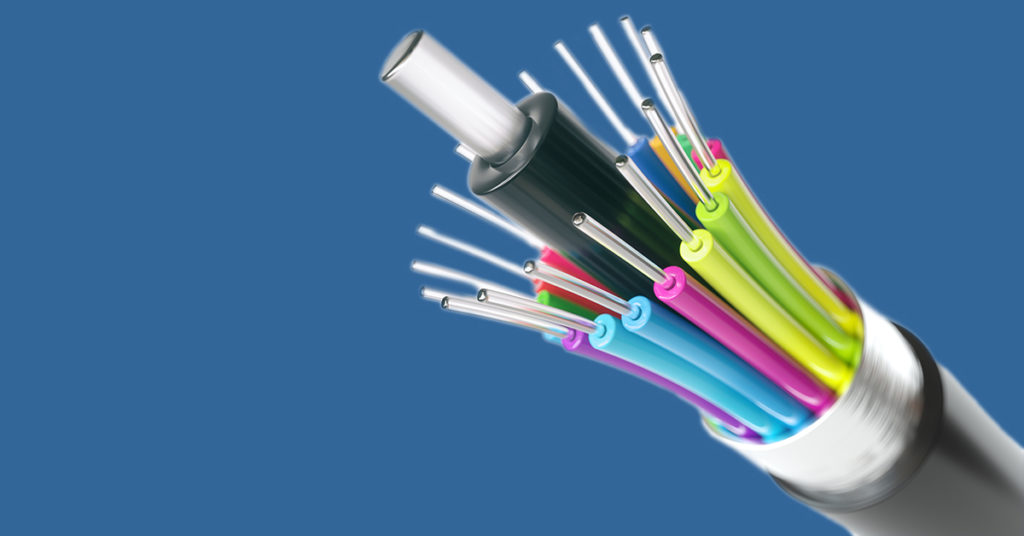
What Is Fiber-Optic Internet?
13 commentsUpdated on May 10, 2023
Internet and technology companies have a well-earned reputation for throwing around fancy buzzwords that, when it comes down to it, mean very little for real people. Occasionally, though, something that sounds like it might just be the latest idea from the marketing department really delivers. This is the case with fiber-optic internet. It’s high-speed broadband service straight from the minds of the engineers and scientists.
Internet inside
Fiber, or fiber-optic, internet is the fastest broadband service widely available. Data is transmitted as beams of light sent (by lasers!) through fiber-optic cables.
Fiber internet is fast because of what’s inside the cables. Fiber-optic cable, also called optical fiber, is made up of three parts: a thin inner “core,” surrounded by a slightly thicker “cladding,” both shielded by a “buffer” layer that protects the fiber layers from being degraded or destroyed by weather.
The core, which is just thicker than a strand of human hair, and the cladding of a fiber-optic cable are normally made from different types of ultra-pure glass. The two work together to transmit light at, well, the speed of light, using a technique called “total internal reflection.” You might have covered it in high school science class, but here’s a refresher.
The glass the core is made from has a higher “refractive index” than the glass the cladding is made from. This means that light travels more slowly through the core than it does through the cladding. You know how when you put your arm into a swimming pool and it looks like it’s bending? That’s because water has a higher refractive index than air. It’s the same scientific principle at play inside fiber-optic cable but, instead of bending and passing through the cladding like the light does in the swimming pool, the light beam is sent through the core at a shallow enough angle that it gets bounced back. This way, a single beam of light gets trapped inside the core, careening along, from cladding sidewall to cladding sidewall, carrying all that important data.
While optical fiber might sound like it would be fragile, it’s anything but. The ultra-pure glass used in its construction is pretty flexible and the buffer does a good job of keeping away moisture, dirt and anything else that could damage the core and cladding. Multiple fiber-optic wires are bundled together into bigger fiber cables that are wrapped in even thicker protective layers and buried underground to keep them safe from floods, hurricanes and other disasters.
Internet at the speed of light
Modern fiber-optic cables have been around for 50 years, but it’s taken a while for the technology to trickle out to regular customers’ homes.
If you have a DSL internet connection, your Instagram Stories and favorite Netflix shows are still traveling along the fiber-optic internet—just not for the last mile or two. The high-speed “backbone” that connects your internet service provider to the internet at large is built of fiber-optic cables. And fiber-optic cables are even sending signals undersea across the Atlantic. It’s only the last link in your connection, the section between your house and the nearest exchange, that’s copper. And that’s where all the slowdown happens.
If you’re fortunate enough to live where you can get a fiber to the home (FTTH) connection, your internet speeds are sorted for the next few decades. You’ve got fiber from your computer to the rest of the internet, delivering nearly identical upload and download speeds.
The fiber future
As science fiction writer William Gibson said, “The future is already here—it’s just not very evenly distributed.” Well, fiber is here now and, over the next few years, it’s going to get much more evenly distributed. This is good news for everyone who wants a fast, stable, weather-safe internet connection.
Frontier Fiber is built for the way you live today—and tomorrow.
If you’re still on the lookout for the right ultra fast internet connection for streaming, gaming, working from home and running your smart home—all with enough bandwidth for everybody, find out about Frontier Fiber. Then check here to see when it’s available at your address.
Product features may have changed and are subject to change.


This is really good.
Is there such thing as wireless fiberoptic transmission ?
Hi Julius, good question! Fiber optic is not wireless, however data can be sent wirelessly through the air over light or lasers. Instead of the medium being a closed and highly efficient environment like a fiber optic cable, it is the air. I suppose it could also be the vacuum of space as well, but in all cases there is the possibility of particles or obstructions. Fiber cable allows the optical signal to be curved or bent around obstacles and is perfectly clear, whereas an optical signal outside of fiber would need to be line of site. Due to these limitations, Wi-Fi over radio waves is a better choice since line of sight, while ideal, isn’t absolutely required. For that reason it’s probably best we keep optical wireless data transmission limited to our TV remotes!
Can I get internet without a phone connection? I took out my landlines when I got my first cell phone.
With Fiber to the Home, yes, absolutely. No phone line required. We’ll bring a fiber optic line to your house and install an Optical Network Terminal. From there your home network would connect using Ethernet or Coaxial wiring that we install or which already exists. We offer phone service over fiber but it’s not required. ^Michael
We have phone service thru a subcontractor to frontier- southern California Telecom service. How will thst change? Will we get our same telephone service plus new internet service? Comcast is our internet and cable provider currently.
Hi Jerry, this is a great question. Since your phone service is through a competitive local exchange carrier (CLEC) currently, nothing would change if you were to sign up for Frontier Fiber. You would have the option to port your number back to our network and we could deliver voice service to your home over the fiber line using VoIP technology. ^Michael
Just had fiber installed less than a week ago.
I would like to unplug the fiber cable to move the moden and plug back in. Is this ok to do? Or will I have to call to get it set back up again.
Hey Robert! There is no modem with a Frontier Fiber installation, the device that would most likely be confused for one and that the optical cable connects to is the Optical Network Terminal (ONT). If this is the device you’re referring to, which is typically mounted to a wall, we would advise against disconnecting anything from it. If you’re referring to your router, also often mistaken for a modem, which is connected to the ONT by Ethernet or Coaxial wiring, this is something that you can definitely work on, disconnect and reconnect. ^Michael
Hello,
Our home has cable wires going to each room. When Verizon first installed Fiber into our condo complex, it brought the Fiber into the garages. They installed a Fiber unit there and then connected to our cable connector. I guess the box in the garage was a converter. So in my home I use internet service only, and use a Linksys cable modem and Linksys 3 unit Velop Wifi router mesh. I can’t seem to find a Cable version of the EERO Pro 6 described. How would I move to your Fiber system.
Great question, Robert! Just like when your original Fiber was installed with the Optical terminal in the garage, we can utilize Ethernet as well as coaxial cable to bring the connection inside, as your current connection does. We use a technology called MoCa which can transport data at speeds up to 2.5Gbps over your existing coax wiring. We can also pull Ethernet cable from garage to interior spaces. ^Michael
I just dug my trench for my electrical power feed to my home. I am going to use the same trench for the Frontier fiber optic line. How much dirt do I need to back fill on top of the electrical? Essentially how much dirt is needed to separate the 2 lines so I don’t get interference?
Thanks
That’s a great question, Bill. If your service with us will be Fiber Optic there would be no interaction with your commercial power since the Fiber is transmitting pulses of light. If your service with us, or one of our cable competitors, is delivered over metallic lines you would want them to be 12 inches apart if they’re parallel. ^Michael